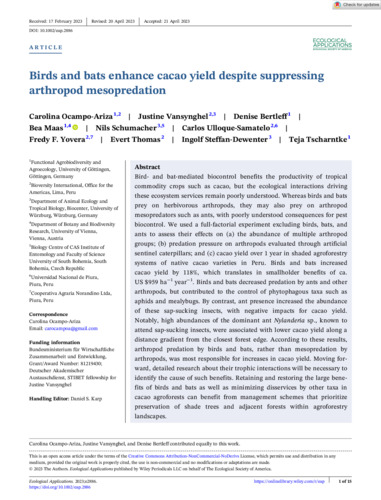Birds and bats enhance cacao yield despite suppressing arthropod mesopredation
Abstract
Bird- and bat-mediated biocontrol benefits the productivity of tropicalcommodity crops such as cacao, but the ecological interactions drivingthese ecosystem services remain poorly understood. Whereas birds and batsprey on herbivorous arthropods, they may also prey on arthropodmesopredators such as ants, with poorly understood consequences for pestbiocontrol. We used a full-factorial experiment excluding birds, bats, andants to assess their effects on (a) the abundanceof multiple arthropodgroups; (b) predation pressure on arthropods evaluated through artificialsentinel caterpillars; and (c) cacao yield over 1 year in shaded agroforestrysystems of native cacao varieties in Peru. Birds and bats increasedcacao yield by 118%, which translates in smallholder benefits of ca.US $959 ha−1year−1. Birds and bats decreased predation by ants and otherarthropods, but contributed to thecontrol of phytophagous taxa such asaphids and mealybugs. By contrast, ant presence increased the abundanceof these sap-sucking insects, with negative impacts for cacao yield.Notably, high abundances of the dominant antNylanderiasp., known toattend sap-sucking insects, were associated with lower cacao yield along adistance gradient from the closest forest edge. According to these results,arthropod predation by birds and bats, rather than mesopredation byarthropods, was most responsible forincreases in cacao yield. Moving for-ward, detailed research about their trophic interactions will be necessary toidentify the cause of such benefits. Retaining and restoring the large bene-fits of birds and bats as well as minimizing disservices by other taxa incacao agroforests can benefit from management schemes that prioritizepreservation of shade trees and adjacent forests within agroforestrylandscapes.

